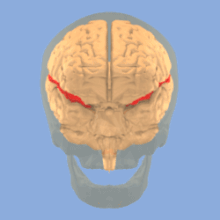Lateral sulcus

Lateral sulcus and operculum
The lateral sulcus - also called fissura sylvii , sylvic fissure , sylvic furrow or fissura lateralis - is an extensive lateral fissure of the brain .
It was first described by Franciscus de la Boe Sylvius in 1641 , which is why it is sometimes referred to as Fissura Sylvii in clinical usage .
It separates the parietal from the temporal lobe . It can be found in both hemispheres, but longer in the left one. The operculum is up to her; in its depth is the island bark . It contains the transverse temporal gyri , which are part of the auditory cortex . The formation of the fissura Sylvii in humans already takes place in the 14th week of pregnancy . So it belongs next to u. a. the longitudinal fissure to the earliest developing sulci.
Individual evidence
- ↑ Federative Committee on Anatomical Terminology (1998). Terminologia Anatomica . Stuttgart: Thieme
- ^ Je G Chi, Elizabeth C Dooling, Floyd H. Gilles: Gyral development of the human brain. In: Annals of Neurology. 1, 1977, pp. 86-93, doi : 10.1002 / ana.410010109 , PMID 560818 .
